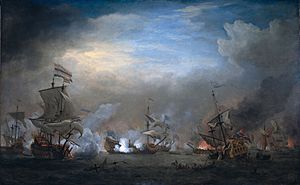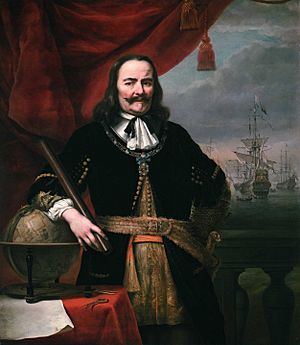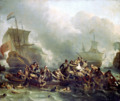Battle of Texel facts for kids
Quick facts for kids Battle of Texel |
|||||||
|---|---|---|---|---|---|---|---|
| Part of the Franco-Dutch War | |||||||
 The Gouden Leeuw at the Battle of Texel, 21 August 1673, Van de Velde the Younger |
|||||||
|
|||||||
| Belligerents | |||||||
|
|||||||
| Commanders and leaders | |||||||
|
|
||||||
| Strength | |||||||
21,000 men |
32,000 men |
||||||
| Casualties and losses | |||||||
| 1,000 killed | 2,000 killed | ||||||
The Battle of Texel was a big naval battle. It happened on August 21, 1673, near the island of Texel. This fight was between the Dutch navy and a combined fleet from England and France.
It was the last major battle of the Third Anglo-Dutch War. This war was part of a bigger conflict called the Franco-Dutch War (1672–1678). During this time, Louis XIV of France, the King of France, had invaded the Dutch Republic. He also wanted to control the Spanish Netherlands. England joined the war because of a secret deal made by King Charles II of England. However, many people in the English Parliament did not like this alliance.
The main leaders of the English and Dutch forces were James, Duke of York (who later became King James II) and William III of Orange (who also became a King of England). Neither of them fought in this specific battle.
Prince Rupert of the Rhine led the combined English and French fleet. They had about 92 warships and 30 fireships. He commanded the center of his fleet. Jean II d'Estrées led the front, and Sir Edward Spragge led the back. The Dutch fleet had 75 ships and 30 fireships. It was led by Lieutenant-Admiral-General Michiel de Ruyter. Adriaen Banckert commanded the front of the Dutch fleet, and Cornelis Tromp led the back. Even though the Dutch ships were generally smaller, their sailors were very skilled and experienced.
Contents
The Battle Begins: A Clever Plan

In July, Prince Rupert sailed out again. He hoped to trick the Dutch fleet into moving north. He pretended to attack cities like The Hague. At first, De Ruyter stayed in a safe spot called Schooneveld. He had already won two battles there.
But then, an important group of Dutch East India Company ships was returning. These ships were full of valuable goods. Capturing them would give King Charles II enough money to keep fighting the war. The Dutch Republic was already struggling financially. They could not afford to lose this treasure. So, William III ordered De Ruyter to go out and fight the enemy.
Even though the Dutch were outnumbered, De Ruyter used a smart plan. He managed to get the "weather gauge." This means his ships were in a better position because of the wind. He sent his front division, led by Adriaen Banckert, to separate the French ships from the main English fleet.
Fierce Fighting and Key Moments
De Ruyter's plan worked well. The French ships could not join the main fight properly. The battle then became a tough struggle between the Dutch fleet and the English center and back divisions. Both sides fought hard for hours and suffered many losses.
The back divisions, led by Spragge and Tromp, kept clashing. Spragge had even promised to capture or kill his old enemy, Tromp. Both commanders had to move their flags to new ships three times because their own ships were too damaged. On the third time, Spragge drowned when his boat sank. His focus on fighting Tromp left the English center exposed. This was a big reason why the smaller but better-led Dutch fleet won.
The fight between the English and Dutch centers continued for hours. The wind kept changing, giving each side an advantage at different times. After breaking away from the French, Banckert's ships joined the Dutch center. The main goal for the Dutch was to capture Spragge's isolated flagship, the Prince. They were not successful.
Eventually, both fleets were exhausted. The English and French ships pulled back. No major ships sank, but many were badly damaged. About 3,000 men died in the battle. Two-thirds of them were English or French.
After the Battle: A Dutch Victory

After the battle, Prince Rupert complained that the French had not fought hard enough. Historians still debate this. Some say the French fought bravely but got separated. Others believe it was on purpose. The French commander, D'Estrées, had orders from King Louis XIV to protect his fleet. He claimed the wind was too weak to attack the Dutch. French officers admitted their fleet was not very involved. They blamed this on their lack of experience.
The combined English and French fleet was very large. This made it hard to control during the battle. The fight also made the English and French trust each other even less. People in England became even more against the war. The battle also ended any hope of stopping Dutch trade by blocking their ports. This made it a huge strategic victory for the Dutch. This battle was one of the greatest moments in De Ruyter's career. Even the Duke of York (later King James II) said De Ruyter was "the greatest that ever to that time was in the world."
Despite losing four ships, the valuable Spice Fleet arrived safely. This brought much-needed money to the Dutch Republic. In the months that followed, the Netherlands made alliances with Spain and the Holy Roman Empire. The threat of invasions from the south and east forced the French to leave Dutch territory. The Third Anglo-Dutch War ended in 1674 with the signing of the Treaty of Westminster. Fourteen years later, the Glorious Revolution happened. This is when William III became King of England. This event finally ended the conflicts between England and the Dutch in the 1600s. The two countries would not fight each other at sea again until the Battle of Dogger Bank in 1781.
Gallery
Sources





